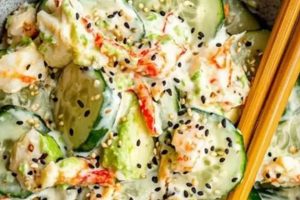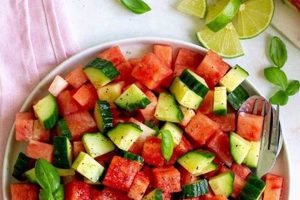Sunomono, a refreshing and light Japanese side dish, typically features thinly sliced cucumbers marinated in a vinegar-based dressing. Variations often incorporate ingredients such as seaweed, sesame seeds, and other vegetables like wakame or carrots. A simple version might involve cucumbers dressed with rice vinegar, sugar, and salt, while more complex versions can include mirin, soy sauce, ginger, and chili flakes for added depth of flavor.
These salads offer a palate-cleansing element in Japanese cuisine, balancing richer, heavier dishes. The vinegar marinade not only adds a tangy flavor but also acts as a natural preservative, extending the shelf life of the cucumbers. Historically, preserving vegetables in vinegar was essential in Japan, and sunomono represents a culinary evolution of this practice. Its refreshing nature makes it especially popular during warmer months. Beyond its culinary appeal, this type of salad offers nutritional value, as cucumbers are a good source of hydration and vitamins.
Exploring the diverse range of flavor profiles available within these preparations reveals a fascinating aspect of Japanese culinary artistry. From the simple elegance of a basic vinegar dressing to the complex interplay of seasonings in regional variations, cucumber salads offer a versatile and appealing culinary experience.
Tips for Preparing Japanese Cucumber Salad
Achieving optimal flavor and texture in cucumber salad requires attention to key preparation techniques. The following tips provide guidance for creating a refreshing and authentic dish.
Tip 1: Salt the Cucumbers: Salting the thinly sliced cucumbers draws out excess moisture, preventing a watery salad and allowing the dressing to adhere more effectively. After 15-20 minutes, gently squeeze out the released liquid.
Tip 2: Choose the Right Vinegar: Rice vinegar provides a mild, slightly sweet acidity that complements the cucumbers. Other vinegars, such as apple cider or white wine vinegar, can be substituted but may alter the traditional flavor profile.
Tip 3: Balance Sweetness and Acidity: Achieving a harmonious balance between the sweetness of sugar and the tanginess of vinegar is crucial. Adjust the proportions to suit personal preferences.
Tip 4: Enhance with Sesame: Toasted sesame seeds add a nutty aroma and satisfying crunch. Sesame oil can also be used sparingly for a richer flavor.
Tip 5: Consider Umami: A touch of soy sauce or a pinch of dried bonito flakes can introduce a subtle umami element, deepening the complexity of the salad.
Tip 6: Chill Before Serving: Chilling the salad allows the flavors to meld and enhances the refreshing qualities of the dish. Serve cold for optimal enjoyment.
Tip 7: Experiment with Ingredients: Explore variations by incorporating other vegetables, such as wakame seaweed or shredded carrots, for added texture and nutritional value.
By following these guidelines, one can elevate a simple cucumber salad into a flavorful and visually appealing component of a Japanese meal. Attention to detail ensures a harmonious balance of textures and flavors, offering a truly satisfying culinary experience.
Understanding these core principles enables the creation of diverse and delectable variations to suit individual preferences and complement a variety of dishes.
1. Thinly Sliced Cucumbers
Thinly sliced cucumbers form the foundation of most Japanese cucumber salads. Their delicate texture and ability to readily absorb the marinade are crucial for achieving the desired flavor profile and refreshing qualities of these dishes. The method of slicing influences both the aesthetic presentation and the overall culinary experience.
- Surface Area and Marinade Absorption
Thinly slicing cucumbers maximizes their surface area, allowing the marinade to penetrate deeply and quickly. This ensures that each bite is infused with the desired flavors, whether a simple vinegar dressing or a more complex blend of seasonings. Greater surface area also facilitates the release of excess moisture from the cucumbers, preventing a watery salad.
- Texture and Mouthfeel
The thin slices contribute a delicate, almost translucent quality to the salad. This contrasts pleasantly with other components, such as crunchy sesame seeds or seaweed. The thinness also makes the cucumbers easier to eat with chopsticks, a crucial consideration in Japanese cuisine.
- Visual Appeal
Thinly sliced cucumbers create an elegant, visually appealing presentation. The translucence of the slices allows light to pass through, showcasing the vibrant green color and creating a refreshing aesthetic. This attention to visual detail is a hallmark of Japanese culinary arts.
- Slicing Techniques and Tools
Various techniques and tools can achieve the desired thinness. Traditional methods include using a sharp knife and meticulous hand-slicing, while a mandoline slicer offers a more efficient approach for achieving consistent thickness. The choice of method influences the final texture and appearance, with hand-slicing often yielding slightly irregular, more rustic slices.
The careful preparation of cucumbers through thin slicing significantly influences the overall success of a Japanese cucumber salad. From flavor absorption and textural contrast to visual appeal, this fundamental step contributes to the refreshing and harmonious experience characteristic of this quintessential Japanese side dish.
2. Rice Vinegar Marinade
Rice vinegar marinade forms the cornerstone of Japanese cucumber salad recipes, contributing significantly to their distinctive flavor profile. The mild acidity and subtle sweetness of rice vinegar provide a refreshing counterpoint to the subtle, slightly sweet flavor of cucumbers. This marinade not only seasons the cucumbers but also acts as a preservative, extending shelf life and enhancing textural integrity by gently pickling the vegetable. The balance of sweet, sour, and salty components in the marinade creates a complex flavor dynamic that distinguishes Japanese cucumber salads from other cucumber preparations. For example, a classic sunomono relies heavily on this balance, often incorporating sugar and salt into the rice vinegar base, sometimes with additions of mirin for sweetness and depth, and soy sauce for a savory, umami note.
The specific composition of the rice vinegar marinade can be adjusted to achieve diverse flavor profiles. Adding ginger or chili flakes introduces a spicy element, while incorporating seaweed, such as kombu, contributes umami and a subtle oceanic flavor. The proportion of sugar to vinegar determines the degree of sweetness, allowing for customization based on individual preferences and the intended balance within a larger meal. Consider a simple cucumber salad served alongside rich teriyaki salmon: a sharper, less sweet marinade provides a palate-cleansing contrast, while a sweeter marinade might complement a lighter dish of steamed fish and rice. Understanding the role and adaptability of rice vinegar marinade enables culinary creativity and the development of well-balanced Japanese meals.
Mastery of rice vinegar marinade preparation is essential for crafting authentic and delicious Japanese cucumber salads. This seemingly simple component plays a multifaceted role, influencing flavor, texture, and preservation. Its versatility allows for a broad spectrum of flavor profiles, from the clean simplicity of a basic vinegar and sugar dressing to the layered complexity of marinades incorporating various aromatics and seasonings. Recognizing the nuanced impact of rice vinegar marinade elevates the understanding and appreciation of this fundamental element in Japanese cuisine.
3. Sesame Seed Garnish
Sesame seeds, frequently employed as a garnish in Japanese cucumber salads, contribute more than mere visual appeal. Their subtle yet distinct flavor and textural presence enhance the overall sensory experience, complementing the refreshing nature of these dishes. Understanding the multifaceted role of sesame seeds in this culinary context provides insight into the nuanced approach to flavor and texture characteristic of Japanese cuisine.
- Flavor Enhancement
Sesame seeds impart a nutty, slightly sweet flavor that complements the mild taste of cucumbers and the tanginess of the vinegar-based dressing. Toasting the seeds before use intensifies their inherent nuttiness, adding depth and complexity to the overall flavor profile. The subtle bitterness of some sesame varieties provides an intriguing counterpoint to the sweetness and acidity of the other components, resulting in a more balanced and nuanced taste experience.
- Textural Contrast
The small, crisp seeds offer a pleasant textural contrast to the tender, sometimes slippery texture of the cucumber slices. This interplay of textures adds a dynamic element to each bite, preventing the salad from feeling monotonous and creating a more satisfying mouthfeel. The delicate crunch of sesame seeds complements the softer elements, enhancing the overall sensory experience.
- Visual Appeal
White and black sesame seeds create visually appealing contrasts against the light green or white backdrop of cucumber slices. The sprinkling of seeds adds depth and visual interest, elevating the presentation from simple to elegant. The visual appeal enhances the overall dining experience, reflecting the Japanese emphasis on aesthetic presentation in cuisine.
- Nutritional Value
Beyond flavor and texture, sesame seeds offer nutritional benefits. They are a good source of healthy fats, fiber, and various minerals, contributing to the overall nutritional value of the salad. While used primarily as a garnish, the nutritional content of sesame seeds adds another layer of value to this seemingly simple culinary element.
The inclusion of sesame seeds as a garnish in Japanese cucumber salads exemplifies the meticulous attention to detail characteristic of Japanese cuisine. From flavor and texture enhancement to visual appeal and nutritional value, sesame seeds play a significant role in elevating these dishes beyond mere refreshment to offer a more nuanced and satisfying culinary experience.
4. Umami Enhancement
Umami, often described as the fifth taste, plays a crucial role in the complexity and balance of Japanese cucumber salads. While the refreshing qualities of these salads derive primarily from the crisp cucumbers and tangy vinegar, the subtle integration of umami provides depth and a savory counterpoint to the brighter flavors. This enhancement contributes to a more complete and satisfying sensory experience, aligning with the Japanese culinary emphasis on harmony and balance.
Several ingredients can contribute umami to these salads. Dried bonito flakes (katsuobushi), a staple in Japanese cuisine, offer a potent dose of umami, imparting a smoky, slightly fishy flavor. Kombu, a type of dried kelp, contributes a more subtle, oceanic umami note. A small amount of soy sauce, with its fermented complexity, can also provide a savory depth. Even a few drops of sesame oil can introduce a richer, nuttier umami element. The choice of ingredient depends on the desired intensity and specific flavor profile sought. For instance, a light cucumber salad served as a palate cleanser might benefit from the delicate umami of kombu, while a more robust salad could incorporate the stronger flavors of bonito flakes or soy sauce.
The judicious use of umami-rich ingredients allows for nuanced flavor layering without overpowering the refreshing essence of the cucumber salad. This careful balancing act exemplifies the sophisticated approach to flavor characteristic of Japanese cuisine. Understanding the role and impact of umami enhancement provides insight into the intricate interplay of flavors that contribute to the unique and satisfying nature of Japanese cucumber salads. This knowledge allows for greater appreciation and more informed culinary experimentation, leading to the creation of dishes that capture the true essence of Japanese culinary artistry.
5. Refreshing, light side dish
Japanese cucumber salads epitomize the concept of a refreshing, light side dish. Several factors contribute to this characteristic. The high water content of cucumbers provides inherent refreshment, further amplified by the chilling effect of refrigeration prior to serving. The thin slicing maximizes surface area, enhancing both the perception of coolness and the absorption of the typically vinegar-based marinade. This marinade, often a balance of sour and sweet, contributes a light, palate-cleansing quality. Such salads offer a counterpoint to richer components of a Japanese meal, such as tempura or grilled meats, providing a refreshing contrast and preventing palate fatigue. For example, a simple sunomono, with its thinly sliced cucumbers and rice vinegar dressing, acts as a refreshing counterbalance to the richness of unagi (grilled eel). This balance contributes to a more harmonious and enjoyable meal.
The refreshing nature of these salads extends beyond mere sensory pleasure. In Japan’s often hot and humid climate, such dishes provide necessary hydration and a welcome respite from heavier fare. Moreover, the light, digestive qualities of cucumber contribute to overall meal satisfaction without causing heaviness. Consider a multi-course kaiseki meal: a light cucumber salad nestled between richer courses cleanses the palate, allowing full appreciation of subsequent flavors. Furthermore, the often vibrant green color of cucumber salads adds a visual element of freshness to the meal presentation, contributing to a holistic dining experience.
Understanding the role of Japanese cucumber salads as refreshing, light side dishes is key to appreciating their significance within Japanese cuisine. These salads are not merely accompaniments but integral components of a balanced and harmonious meal. They exemplify the Japanese culinary philosophy of respecting seasonal ingredients and prioritizing balance in flavor, texture, and temperature. This approach enhances not only the sensory experience but also contributes to overall well-being, reflecting a holistic approach to food and dining.
Frequently Asked Questions
This section addresses common inquiries regarding Japanese cucumber salads, providing concise and informative responses to facilitate understanding and successful preparation.
Question 1: What is the purpose of salting cucumbers before preparing the salad?
Salting draws out excess moisture, preventing a watery salad and allowing the dressing to adhere more effectively. This process also enhances the cucumbers’ crisp texture.
Question 2: Can other types of vinegar be substituted for rice vinegar?
While other vinegars, such as apple cider or white wine vinegar, can be used, they may alter the traditional flavor profile. Rice vinegar offers a mild, slightly sweet acidity ideal for these salads.
Question 3: How can one achieve the proper balance of sweetness and acidity in the dressing?
The balance depends on personal preference. Start with a basic recipe and adjust the sugar and vinegar proportions until the desired balance is achieved. Taste-testing is crucial.
Question 4: What are the benefits of using toasted sesame seeds?
Toasting enhances the nutty flavor of sesame seeds and adds a pleasant crunch to the salad, complementing the soft texture of the cucumbers.
Question 5: How long can cucumber salad be stored in the refrigerator?
Properly stored in an airtight container, it can typically last for 2-3 days in the refrigerator. However, the texture may soften slightly over time.
Question 6: Beyond cucumbers, what other vegetables can be included?
Wakame seaweed, shredded carrots, and thinly sliced daikon radish are common additions that provide textural and flavor variety.
Careful preparation and attention to detail ensure the creation of a refreshing and authentic Japanese cucumber salad. Addressing these common questions provides a foundation for successful culinary endeavors.
This comprehensive overview equips readers with the knowledge and understanding needed to create and appreciate this essential element of Japanese cuisine.
Japanese Cucumber Salad Recipes
Exploration of Japanese cucumber salad recipes reveals a deceptively simple dish offering nuanced flavor profiles and culinary artistry. From the careful slicing of cucumbers to the delicate balance of vinegar, sweetness, and umami in the marinade, each step contributes to the final product. The addition of sesame seeds provides not only visual appeal but also textural and flavor enhancement. The refreshing nature of these salads, often served as a counterpoint to richer dishes, highlights their integral role in a balanced Japanese meal. Variations incorporating seaweed, other vegetables, or different seasonings showcase the adaptability and versatility within this culinary tradition.
Further exploration of regional variations and ingredient combinations offers a pathway to deeper understanding and appreciation of Japanese culinary traditions. The simplicity of Japanese cucumber salad recipes belies a complex interplay of flavors and textures, inviting continued exploration and culinary creativity. Mastery of these seemingly simple preparations provides a foundation for appreciating the nuanced artistry within Japanese cuisine.






